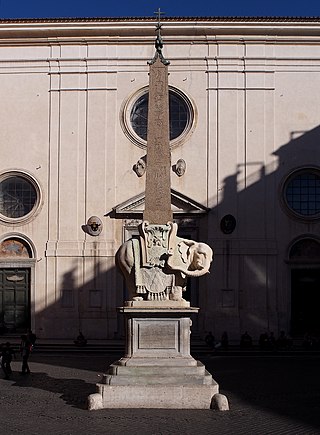
An obelisk is a tall, four-sided, narrow tapering monument which ends in a pyramid-like shape or pyramidion at the top. Originally constructed by Ancient Egyptians and called tekhenu, the Greeks used the Greek term obeliskos to describe them, and this word passed into Latin and ultimately English. Though William Thomas used the term correctly in his Historie of Italie of 1549, by the late sixteenth century, Shakespeare failed to distinguish between pyramids and obelisks in his plays and sonnets. Ancient obelisks are monolithic and consist of a single stone; most modern obelisks are made of several stones.

The Papal Archbasilica Cathedral of the Most Holy Savior and of Saints John the Baptist and the Evangelist in the Lateran is the Catholic cathedral church of the Diocese of Rome in the city of Rome, and serves as the seat of the bishop of Rome, the pope. The archbasilica lies outside of Vatican City proper, which is located approximately 4 kilometres (2.5 mi) to the northwest. Nevertheless, as properties of the Holy See, the archbasilica and its adjoining edifices enjoy an extraterritorial status from Italy, pursuant to the terms of the Lateran Treaty of 1929. Dedicated to the Christ, in honor of John the Baptist and John the Evangelist, the place name, Laterano (Lateran) comes from an ancient Roman family (gens), whose palace (domus) grounds occupied the site; the adjacent Lateran Palace was the primary residence of the pope until the Middle Ages.

Menmaatre Seti I was the second pharaoh of the Nineteenth Dynasty of Egypt during the New Kingdom period, ruling c. 1294 or 1290 BCE to 1279 BCE. He was the son of Ramesses I and Sitre, and the father of Ramesses II.

Saint Peter's Square is a large plaza located directly in front of St. Peter's Basilica in Vatican City, the papal enclave in Rome, directly west of the neighborhood (rione) of Borgo. Both the square and the basilica are named after Saint Peter, an apostle of Jesus whom Catholics consider to be the first Pope.

The Lateran Palace, formally the Apostolic Palace of the Lateran, is an ancient palace of the Roman Empire and later the main papal residence in southeast Rome.

Domenico Fontana was an Italian architect of the late Renaissance, born in today's Ticino. He worked primarily in Italy, at Rome and Naples.

Campo Marzio is the 4th rione of Rome, Italy, identified by the initials R. IV. It belongs to the Municipio I and covers a smaller section of the area of the ancient Campus Martius. The logo of this rione is a silver crescent on a blue background.

The Church of Santissima Trinità dei Monti, often called simply Trinità dei Monti, is a Roman Catholic late Renaissance titular church in Rome, central Italy. It is best known for its position above the Spanish Steps which lead down to the famous Piazza di Spagna. The church and its surrounding area are a French State property.

Piazza del Popolo is a large urban square in Rome. The name in modern Italian literally means "People's Square", but historically it derives from the poplars after which the church of Santa Maria del Popolo, in the northeast corner of the piazza, takes its name.

The Porta del Popolo, or Porta Flaminia, is a city gate of the Aurelian Walls of Rome that marks the border between Piazza del Popolo and Piazzale Flaminio.

The Lateran Obelisk is the largest standing ancient Egyptian obelisk in the world, and it is also the tallest obelisk in Italy. It originally weighed 413 tonnes, but after collapsing and being re-erected 4 metres (13 ft) shorter, now weighs around 300 tonnes. It is located in Rome, in the square across from the Archbasilica of St. John Lateran and the San Giovanni Addolorata Hospital.

The Obelisk of Montecitorio, also known as Solare, is an ancient Egyptian, red granite obelisk of Psamtik II from Heliopolis. Brought to Rome with the Flaminio Obelisk in 10 BC by the Roman Emperor Augustus to be used as the gnomon of the Solarium Augusti, it is now in the Piazza Montecitorio. It is 21.79 metres (71 ft) high, and 33.97 metres (111 ft) including the base and the globe.
Ships were used during the Eighteenth Dynasty of ancient Egypt to transport obelisks from the quarry to their destination. Fifteen centuries later, the Romans used ships to transport obelisks across the Mediterranean to Rome. Today, eight ancient Egyptian obelisks stand in Rome, though not in their original places. The first of the obelisks, the 263-ton Flaminian obelisk, was transported from Heliopolis – modern-day Cairo – in 10 BCE. while the last, the 500-ton Lateran obelisk, was transported from Karnak.

Elephant and Obelisk is a statue of an elephant carrying an obelisk, designed by the Italian artist Gian Lorenzo Bernini. It was unveiled in 1667 in the Piazza della Minerva in Rome, adjacent to the church of Santa Maria sopra Minerva, where it stands today.

Via dei Coronari is a street in the historic center of Rome. The road, flanked by buildings mostly erected in the 15th and the 16th century, belongs entirely to the rione Ponte and is one of the most picturesque roads of the old city, having maintained the character of an Italian Renaissance street.

The Boboli obelisk, previously called the Obelisco Mediceo, is an ancient Egyptian granite obelisk, which was moved in the 18th century from Rome to Florence, where it was erected in the Boboli Gardens.

Cleopatra's Needle in London is one of a pair of obelisks, together named Cleopatra's Needles, that were moved from the ruins of the Caesareum of Alexandria, in Egypt, in the 19th century. Inscribed by Thutmose III and later Ramesses II of the Egyptian New Kingdom, the obelisk was moved in 12 BC to Alexandria, where it remained for over 1,800 years.

The following outline is provided as an overview of and topical guide to Rome:


















